Food Safari
A food lover's journal..
- Crazy for Chocolate
- Kitchen 101
- Me, Myself and I
- On The Hunt
- Quick Meals
- Sheer Indulgence

The Versatile Paella
- World Dishes
Post navigation
When someone mentions Spanish cuisine , most likely Paella comes to mind. A lot of non- Spaniards regard it as Spain’s national dish when in fact, most Spaniards view it as a regional Valencia dish. Mainly there are three types of paella: Valencian paella ( paella valenciana ), seafood paella ( paella de marisco ) and mixed paella ( paella mixta ), but there are literally hundreds of recipes and each cook has their own favorite one. I think we could say that the mixed paella is the most popular and what comes to mind among non-Spaniards and served mostly in Spanish-themed restaurants.
Paella is very versatile. It is one of the things I like about the dish. You can substitute hard to find ingredients with more readily available ones. Having said that, I try hard to stick with what’s on the list of ingredients, at least the main ones which give the distinctive flavor of a particular paella recipe. One thing I am particular with when cooking paella is having the right pan, the paellera . It is traditionally round, shallow and made of polished steel with two handles. I know this may sound shallow but when I bought my paellera, I made sure it was made in Spain. It gives me the satisfaction knowing I have something authentic, paella-cooking wise. 🙂
Another essential item I am particular with when I cook paella would be the rice I use. Of course you may use arborio rice if the short-grain Spanish bomba rice is not available. But I would go out of my way finding bomba rice first. It expands in width, not it length and able to absorb three times its volume in liquid, thus making it the best rice to use when making paella. Another good thing about bomba rice is when cooked, the grains do not stick together and remain separate. It is a bit more pricey than the other types of rice but I really think it is worth it.
One of my biggest favourites : ))
Yeah … me too 🙂
I love your pan and I think that is probably the best look paella I have ever seen – it is truly beautiful.
Thank you. That was nice of you to say. 🙂
Wow, yum!! I agree with frugalfeeding…your paella is ridiculously good looking!!
😀 …Thank you and must be really good too coz my son ate half of it….oh well, growing boy …15 yrs old 🙂
Yummy! I’ve yet to try this dish here in Vancouver but boy am I searching lol 😀
No Paella in Vancouver? Man, you’re missing a lot! 😀
You’re telling me! it’s inhumane! you’d be surprised how much food Vancouver is deprived of, to think we are trying to promote multiculturalism 😀
Then you should come to Oz. Love the food here – very multicultural! 🙂
Pingback: Cooking With Friends | Not the Family Business!
Pingback: Griddled Steak with Cooked Tomato Salsa « Food Safari
Pingback: Paella Valenciana « Food Safari
Pingback: Chicken Brochettes With Vegetable Rice « Food Safari
Leave a comment Cancel reply
- Already have a WordPress.com account? Log in now.
- Subscribe Subscribed
- Copy shortlink
- Report this content
- View post in Reader
- Manage subscriptions
- Collapse this bar
You must be logged in to post a comment.
- Skip to primary navigation
- Skip to main content
- Skip to primary sidebar
August 26, 2024
Spanish Paella Recipe
Let’s make Spanish Paella! the most beloved Spanish dish, with an impressive combination of colorful medley saffron-infused short-grain rice mixed with chicken, juicy seafood, and fresh vegetables. Perfect for a festive family meal and a showstopper!

You can make a delicious, authentic, and easiest Spanish Paella recipe in your kitchen with simple ingredients like rice, saffron, vegetables, chicken, and seafood. If you love cooking International food, you will fall in love with this comforting dish! The best part is you can customize it according to your own personal preference or what you have on hand!
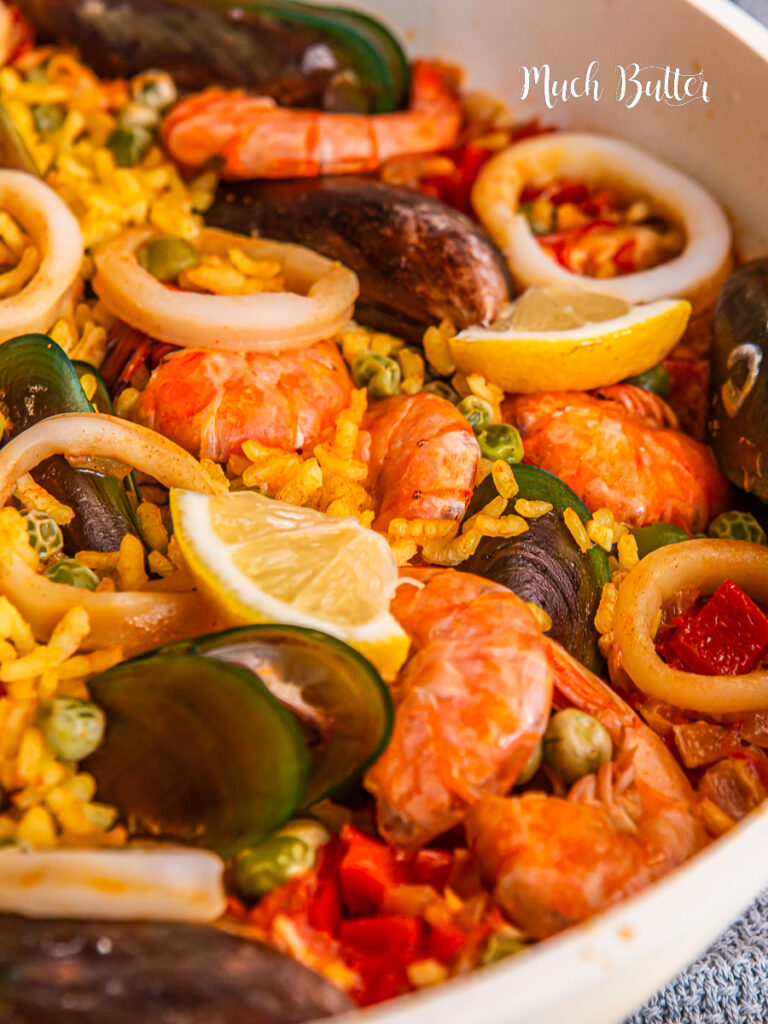
What is Paella?
Paella is a classic Spanish dish that’s a real crowd-pleaser. It features a delicious mix of rice, vegetables, meat, and seafood, all brought together with a touch of saffron for that unique flavor and vibrant color. The name “paella” (pronounced “pie-AY-uh”) actually comes from the wide, shallow pan called a paellera that it’s traditionally cooked in. Whether we’re out enjoying Spanish food at a restaurant or making it at home for a special occasion, paella always brings a sense of celebration to the table.
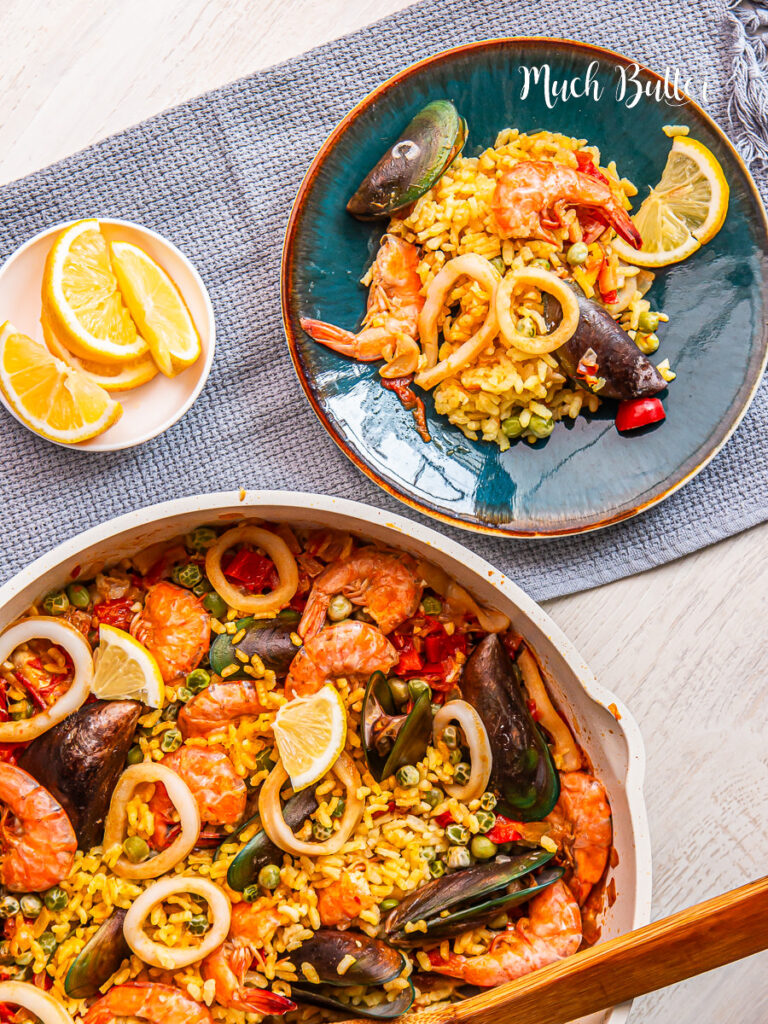
Originating from Valencia, paella has become a beloved dish across Spain and beyond. It’s so versatile—there’s chicken paella, seafood paella, or mixed paella, which combines various meats, seafood, and veggies. It’s like a party in a pan, perfect for sharing with family and friends.
By the way, The type of rice you use for paella is crucial to achieving the perfect texture and flavor. The traditional rice used in paella is a short-grain variety known as Bomba rice. Bomba rice is a high-quality rice that absorbs the flavors of the other ingredients and retains its texture when cooked in the broth.

Another type of rice that can be used for paella is Calasparra rice, which is another short-grain variety also grown in Spain. In general, it’s best to use short-grain rice with a high starch content for paella, as this type of rice can absorb the liquid and flavors of the other ingredients without breaking apart or becoming sticky.
Let’s embark on a culinary journey to Spain and create a delicious and authentic Spanish Paella! This iconic dish, known for its vibrant colors, rich flavors, and hearty ingredients, is a true celebration of Spanish cuisine. With a little guidance, you can easily whip up a mouthwatering paella right in your own kitchen.
Ingredients of Spanish Paella
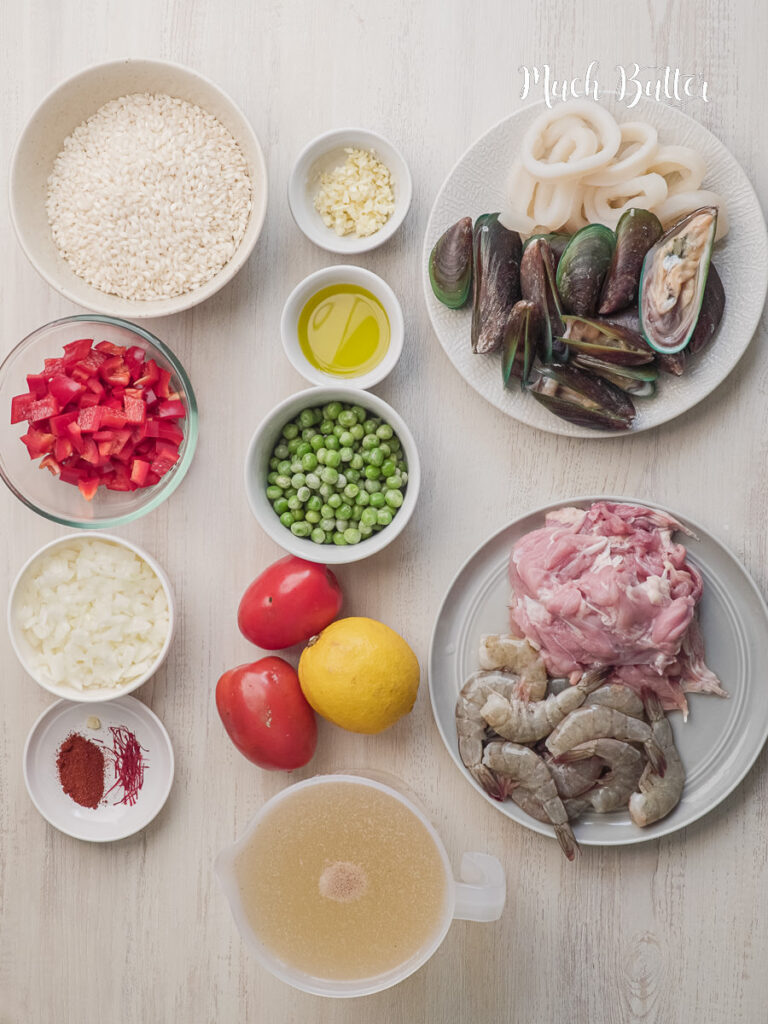
- Extra Virgin Olive Oil; as the base for sautéing the aromatics (onion, garlic, and bell pepper), this oil imparts a rich, fruity flavor to the dish. You can change to regular virgin olive oil
- Onion diced and Garlic minced; infuses the paella with a savory, aromatic note, complementing the other ingredients in the Spanish Paella.
- Red Bell Pepper diced; adds sweetness, a hint of smokiness, and a vibrant color to the paella
- Tomatoes diced; contribute acidity and sweetness to the sofrito, creating a rich, flavorful base for the paella.
- Paprika Powder; adds a smoky depth and vibrant red color to the paella, enhancing the overall flavor profile and giving the dish a warm, earthy taste.
- Saffron Threads; are essential in traditional paella, providing a subtle, earthy flavor and the characteristic golden hue to the rice. This is the signature spice in paella, giving the dish its golden color and a distinct, aromatic flavor. This may be the most important ingredient, so it’s best to buy high-quality products. The orange-red threads give the paella its signature color and a wonderful aromatic quality.
- Frozen Peas; add a pop of color, sweetness, and texture to the paella, balancing the savory and rich elements of the dish.
Main Ingredients;
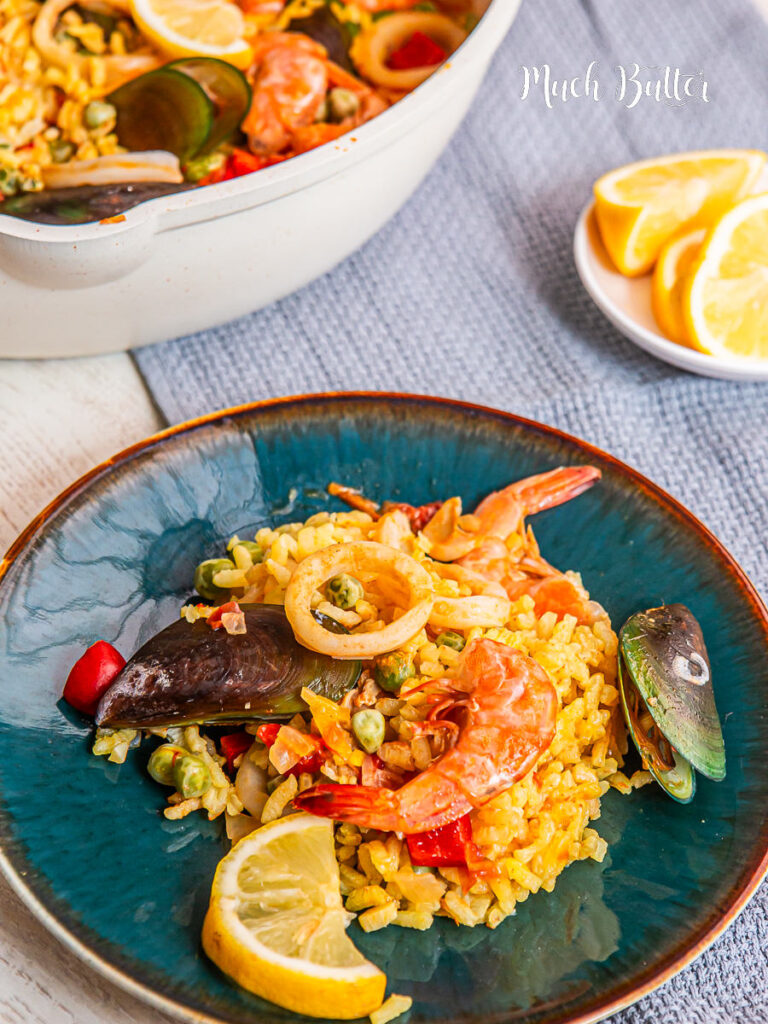
- Chicken Thigh Fillet boneless and skinless, diced; adds protein and richness to the paella, contributing to the dish’s hearty nature. I prefer thighs to breasts in the recipe since they don’t dry out as easily during longer cooking times.
- Spanish Rice; Spanish rice, such as Bomba or Calasparra, is a short-grain rice known for its ability to absorb liquid without becoming mushy. is the foundation of the paella, absorbing the flavors from the broth, saffron, and other ingredients, while maintaining a firm, yet tender texture. This is a particular kind of Spanish rice that is the key ingredient for making really great traditional paella.
- Chicken Broth; serves as the cooking liquid for the rice, infusing it with rich, savory flavors. Authentic paella would include making your own fish stock from the discarded shells of seafood. I usually substitute chicken broth, for convenience.
- medium Shrimp or Prawn shells on; add a briny, sweet flavor to the paella, enhancing its seafood profile. The shells also contribute to the richness of the broth as they cook.
- Calamari Rings; add a subtle, oceanic flavor and a tender, chewy texture to the paella, complementing the other seafood ingredients
- Fresh Green Mussel; contributes to the seafood flavor of the paella, releasing their juices into the broth, which enriches the dish’s overall taste.
- Lemon garnish; adds a fresh, acidic contrast to the rich and savory flavors of the paella. Squeezing lemon juice over the finished dish enhances its overall flavor, providing a refreshing balance to the heaviness of the seafood and chicken.
How to Make Spanish Paella
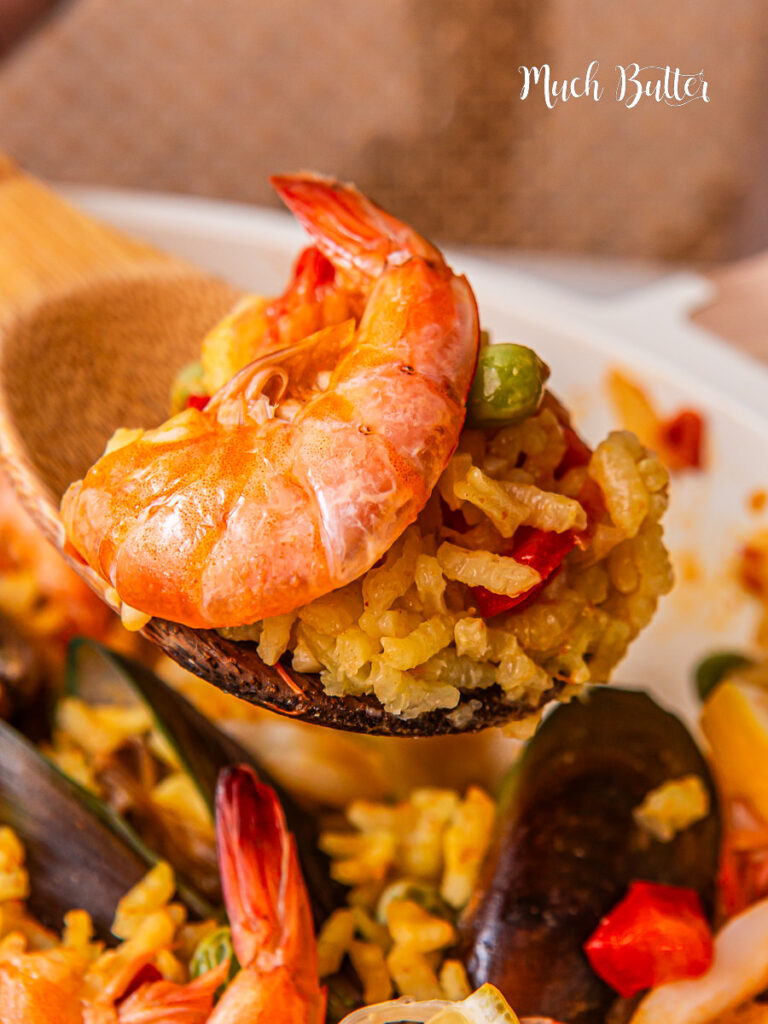
Begin by heating the olive oil in a pan over medium heat. Once the oil is hot, add the diced onion, minced garlic, and diced red bell pepper. Sauté the mixture, stirring occasionally, until the vegetables become soft and fragrant, about 3-5 minutes. Stir in the diced tomatoes, paprika powder, and saffron threads. Cook until the tomatoes break down slightly and the spices infuse the oil, creating a rich, aromatic base for the paella.

Add the diced chicken thigh fillet to the pan. Cook for about 2 minutes, stirring frequently, until the chicken starts to brown slightly on the outside.

Add the Spanish rice to the pan, stirring it into the mixture to coat each grain with the flavored oil and spices. Cook for about 1 minute, allowing the rice to toast slightly, which will help it absorb the broth and develop a rich flavor.
Cook the Rice
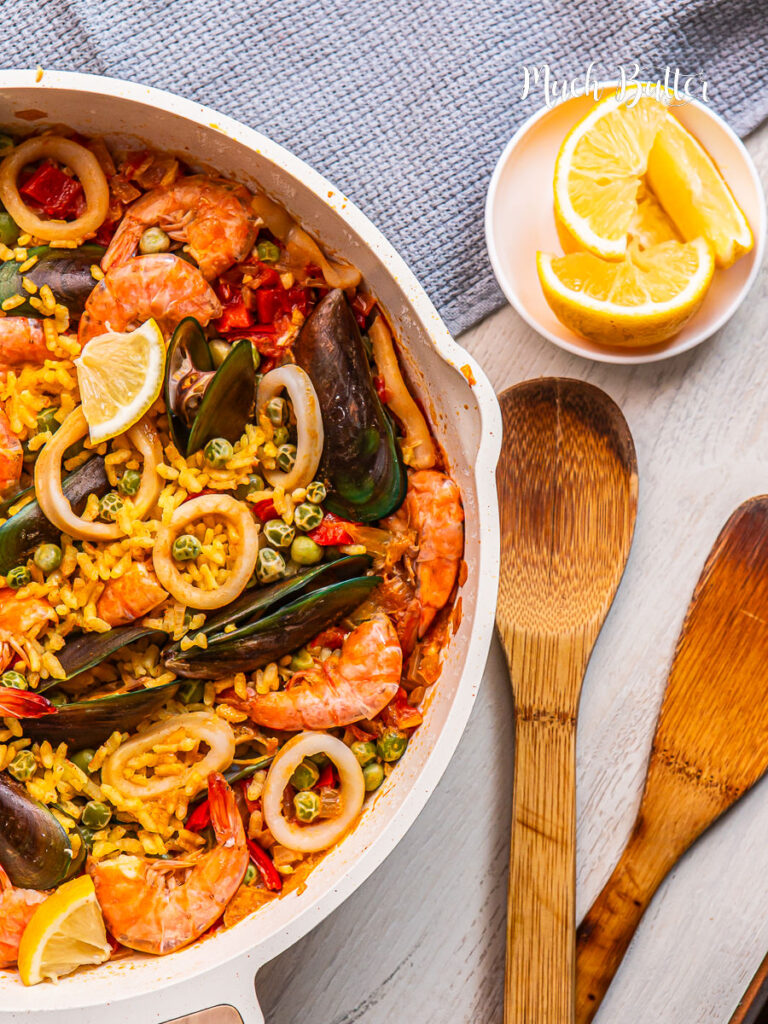
Pour in the chicken broth, ensuring that all the rice is submerged in the liquid. Stir gently to combine the ingredients, then shake the pan lightly to spread the mixture into an even layer. Increase the heat to bring the broth to a simmer. Once simmering, reduce the heat to medium-low and let the Spanish Paella cook undisturbed for 10 minutes. During this time, resist the urge to stir the mixture. Just give a gentle shake for a couple of times during cooking.
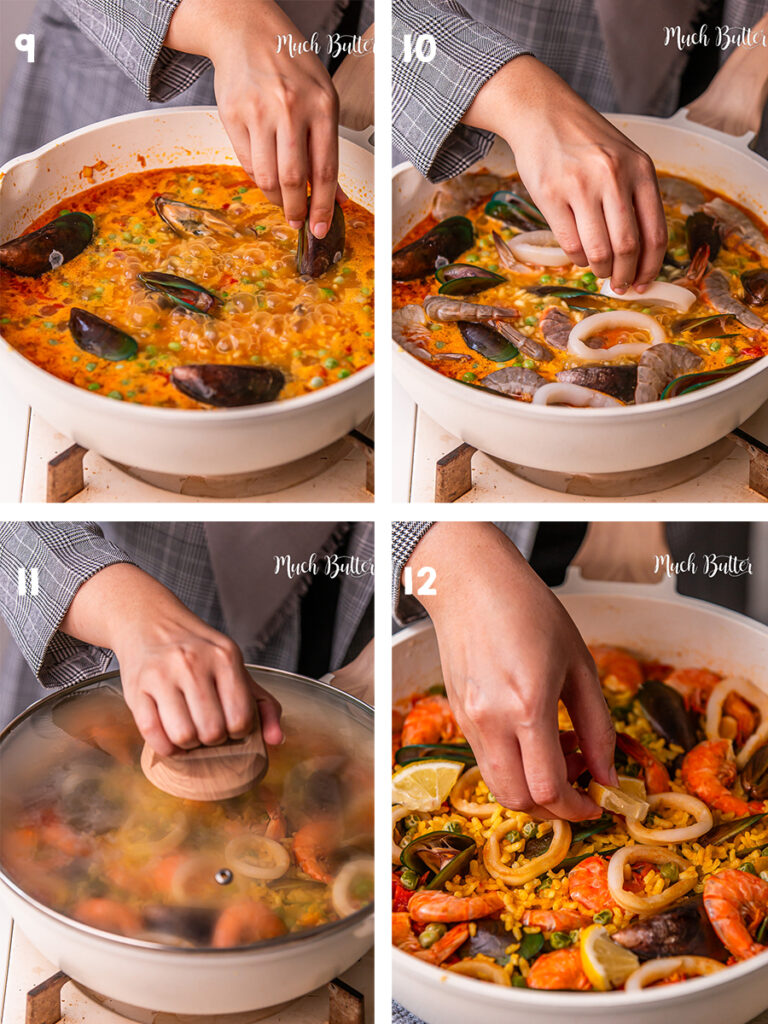
After the initial simmering time, sprinkle the frozen peas evenly over the top of the rice. Arrange the shrimp, calamari rings, and green mussels on top, gently pressing them into the rice. Continue cooking for another 10 minutes, or until the shrimp turn pink and opaque, the mussels have opened, and most of the liquid has been absorbed. If the rice is not fully cooked and still has a bit of crunch, add a little more water or broth, and continue cooking until the rice is tender.

Once the Spanish paella is done cooking, remove the pan from the heat. Cover the pan with a lid or aluminum foil and let the paella rest for 10 minutes. This resting period allows the flavors to meld and the rice to finish cooking through steam.
Just before serving, garnish the paella with lemon slices. The lemon adds a bright, acidic contrast to the rich, savory flavors of the dish. Serve the Spanish Paella directly from the pan, family-style, for everyone to enjoy. Serve this delicious paella in the center of your table so everyone can dig in!

Are you Interested in cooking this recipe?
Let me know your results by uploading pictures and tagging us on Instagram at much.butter and Pinterest. For cooking videos, check and subscribe to our Youtube page and this website . You can join our email for the latest idea menus.
Thank you, your supports are so much appreciated 💕
SEE OTHER SEAFOOD IDEAS:
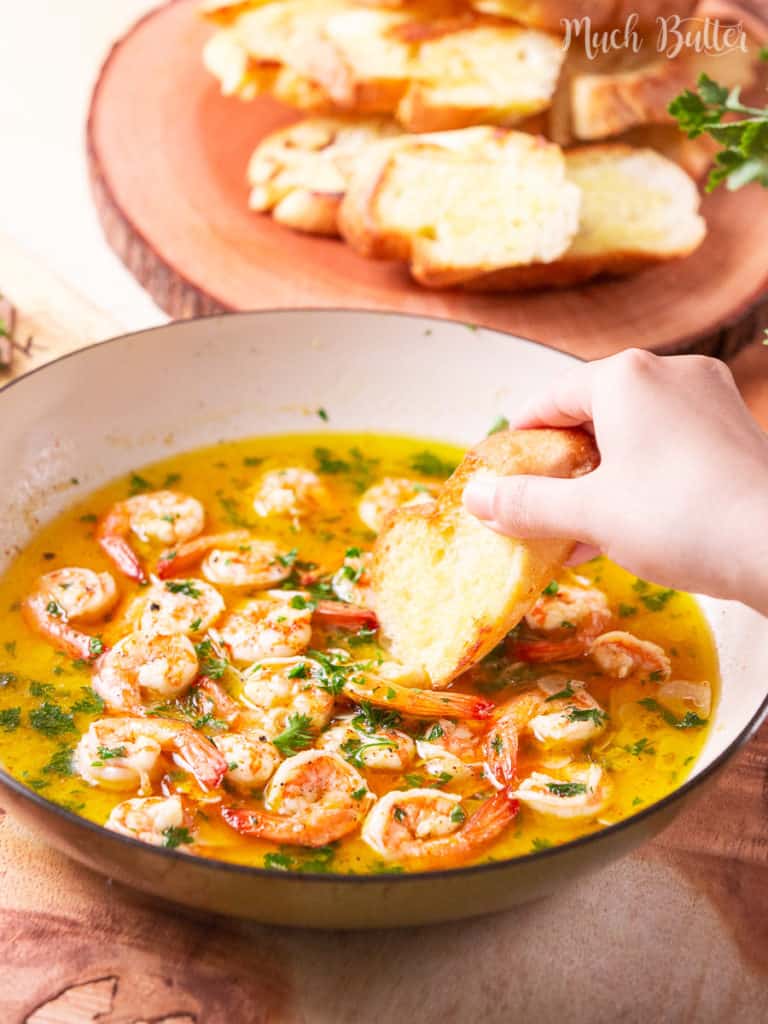
Gambas Al Ajillo
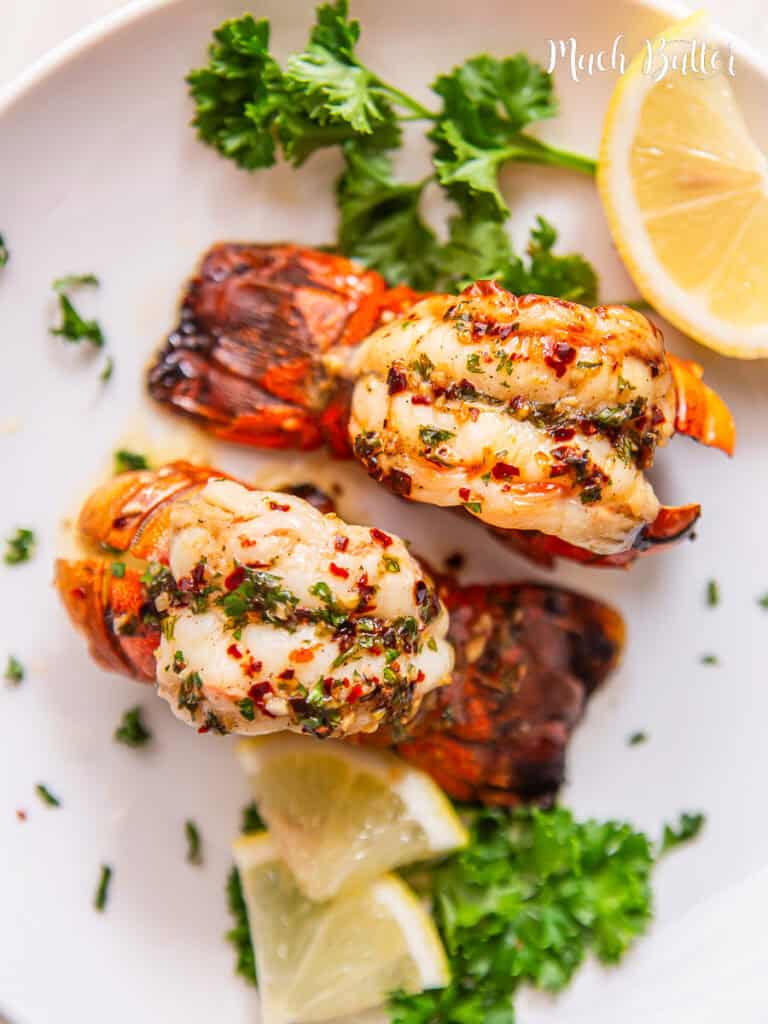
Garlic Butter Lobster Tail
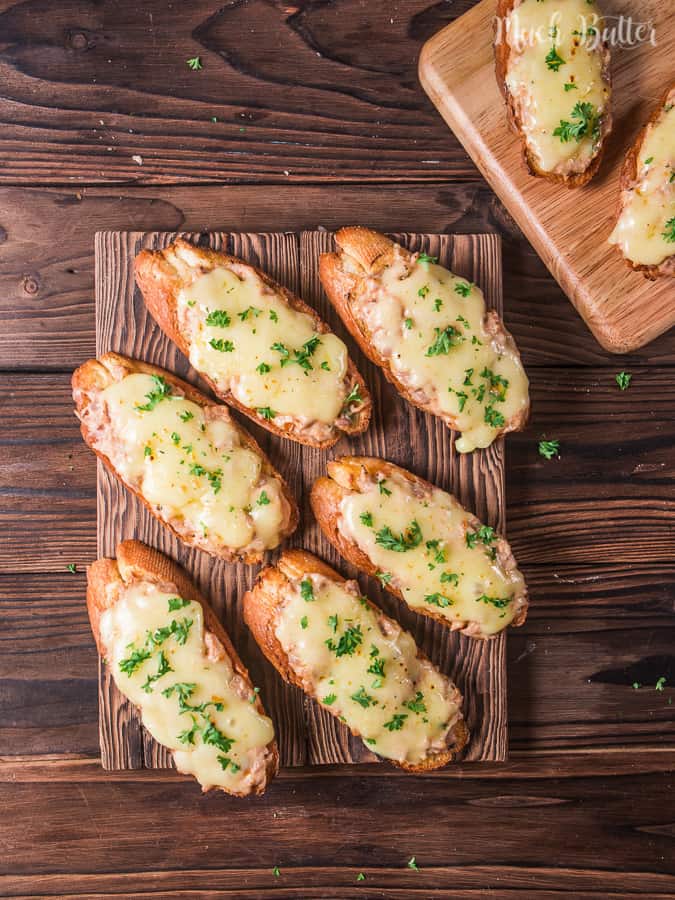
Tuna Melt Bruschetta
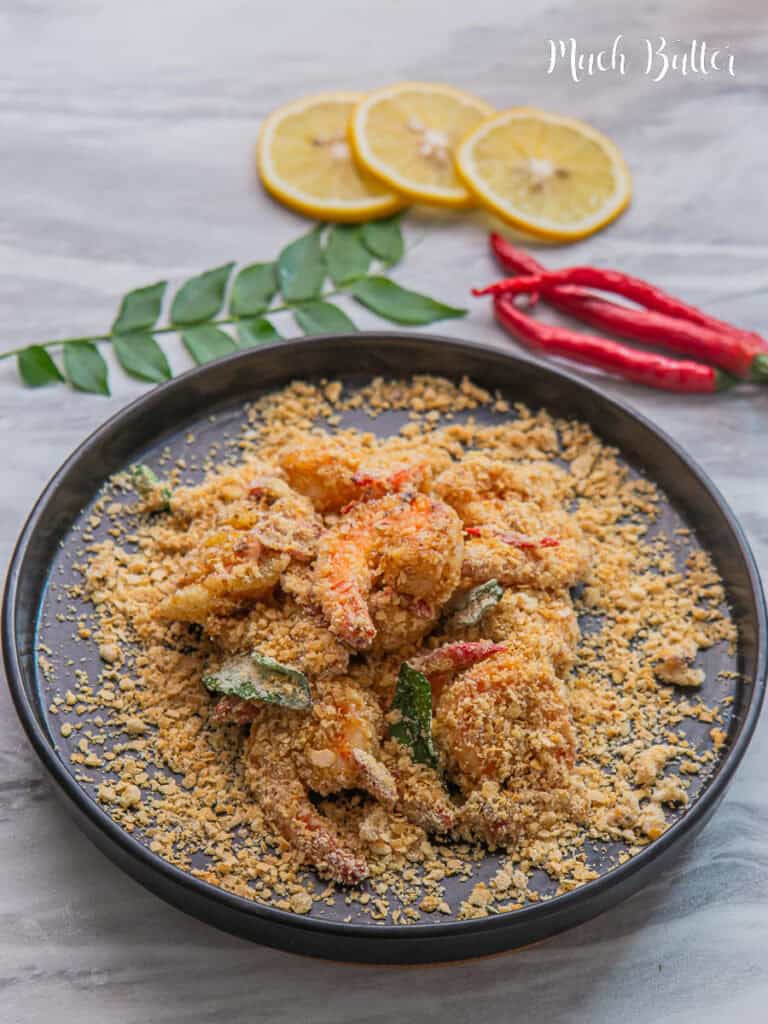
Cereal Butter Prawn

Ingredients
- ⅛ cup Extra Virgin Olive Oil
- 1 Onion diced
- 3 clove Garlic minced
- 1 Red Bell Pepper diced
- 2 Tomatoes diced
- 1 tsp Paprika Powder
- 1 tsp Saffron Threads
- 200 g Chicken Tight Fillet boneless and skinless, diced
- 1½ cup Spanish Rice
- 4 cup Chicken Broth
- ½ cup Frozen Peas
- 12 medium Shrimp or Prawn shell on
- Calamari Rings
- 200 g Fresh Green Mussel
- Lemon garnish
Instructions
Heat olive oil over medium heat, cook onion, garlic, and bell pepper until fragrant. Add tomatoes, paprika powder, and saffron threads and cook for 3 minutes.
Add chicken, cook for 2 minutes then add rice and stir for 1 minute. Pour chicken broth and stir. Shake the pan to make an even layer then simmer for 10 minutes. While simmering the paella, do not stir the mixture, just give a gentle shake for a couple times during cooking.
Sprinkle peas on top and add shrimp, calamari, and green mussels into the rice. Cook again for 10 minutes or until the shrimps is opaque and most of the liquid is absorbed. If the rice is still uncooked, add a bit more water and continue cooking.
Remove the pan from heat then cover it with the lid and rest it for 10 minutes. Garnish with lemon slice and serve, enjoy!
Let's make this recipe and comment below
Reader Interactions
Leave a reply cancel reply.
Your email address will not be published. Required fields are marked *
From saffron to socarrat: the secrets behind authentic Spanish paella
- 10 mins read
Paella (pronounced pai·ei·uh ) is a classic Spanish rice recipe that brings together a delightful medley of flavors.
It is a one-pan wonder, traditionally cooked and served in a large, shallow pan.
While its origins lie in Valencia, Spain, it has become a beloved national dish with various regional variations.
Spanish paella has a fascinating history.
While paella may have ancient roots, its modern form as we know it nowadays emerged in the 19th century.
Its origins lie in the Valencian region, specifically in the rural area around the Albufera lagoon, which is adjacent to the city of Valencia on the Mediterranean coast of Spain.
Farmers and day laborers in Valencia would take leftover food from Moorish feasts and cook it over an open flame during their lunch breaks. This practice gave birth to the delicious Spanish rice and protein dish we know today.
The traditional pan used to cook Spanish paella, known as a paellera , became synonymous with this dish. The Valencian region is believed to be the original home of paella. The dish takes its name from the wide, shallow pan used to prepare it over an open fire. In Valencian/Catalan, “paella” simply means a frying pan.

Paella Valenciana
The traditional paella of the Valencia region is called “Paella Valenciana”.
It is believed to be the original recipe and consists of round-grain rice, green beans and butter beans, rabbit and chicken, all cooked in olive oil and chicken broth. This rice dish was seasoned with saffron or substitutes like turmeric and calendula, and sometimes rosemary. Artichoke hearts and stems may be used as seasonal ingredients.
Over time, other popular local variations of paella emerged throughout the Mediterranean area, the rest of Spain, and internationally. Seafood lovers enjoy Spanish paella de marisco (seafood paella), while paella mixta combines meat, seafood, vegetables and rice in a delightful medley.
Paella’s rich heritage symbolizes the union of cultures—the Roman influence providing the utensil (the paellera) and the Arab influence introducing rice as a staple.
What is socarrat in Spanish paella?
Socarrat is the golden-brown crust that forms on the bottom of a well-cooked Spanish paella.
It is a prized and flavorful layer that develops as the rice cooks and absorbs the liquid in the pan. The socarrat adds a delightful contrast in texture to the tender rice and other ingredients, providing a slightly crispy and caramelized bite.
Paella aficionados consider it a sign of a perfectly executed dish!

What are essential ingredients for Spanish paella?
What should you definitely add to a Spanish paella?
Here are the key ingredients that make up this delicious dish.
The heart of paella, short-grain rice is essential. It soaks up the flavors and develops a rich, creamy texture.
Choosing the right type of rice is crucial for achieving that perfect texture and flavor. Let’s look into the rice varieties that work best for Spanish paella.
Arroz Bomba (Valencia Rice)
Bomba is the gold standard for Spanish paella. It is a short-grain, almost round rice with a pearly color. What makes bomba exceptional is its ability to absorb 3 times its volume in water during cooking. This means it soaks up more flavor without becoming overly sticky. When cooked, bomba rice expands like an accordion, reaching 3 times the length of the raw grain.
Its texture remains creamy and separate, making it ideal for paella.
Senia and Bahia
These are other short-grain rice varieties similar to bomba.
Like bomba, they also absorb more liquid than average rice grains and retain a creamy texture after cooking.
Arborio Rice
Although not traditional to Spain, arborio rice is commonly used in paella outside of Valencia.
Arborio is known for its high starch content, which results in a creamy consistency. It is the same rice used for making risotto, so it works well in seafood or mixed paellas.
Calasparra Rice
Calasparra is another Spanish short-grain rice variety.
It absorbs flavors beautifully and maintains a firm texture. Calasparra rice is often used in Spanish paella de marisco (seafood paella).

Saffron plays a crucial role in authentic Spanish paella, enhancing both its flavor and appearance.
Known as the “red gold,” saffron infuses paella with an intense and earthy taste. When added early in the cooking process, it releases its unique flavor and aroma, creating a rich and savory profile for the dish.
Saffron adds a beautiful golden hue to the rice, making paella visually appealing. Its color is an integral part of the dish’s identity.
In the Valencian community where paella comes from, saffron is one of the 10 basic ingredients required for an authentic “paella Valenciana.”
You can use saffron powder straight to the paella, or saffron threads: soak them in a couple of tablespoons of water for 10 minutes and then add it all to the paella.
3. Meat & seafood
When preparing Spanish paella , you have several protein options to choose from.
Chicken is a classic choice for paella, it adds a hearty and savory flavor to the dish.
In traditional Valencian paella, rabbit is a common protein. It provides a unique taste and pairs well with the other ingredients.
While not used in all paella variations, seafood is a popular option too. Shrimp, mussels, clams, langoustines, octopus, squid and squid ink can be added for a delightful seafood paella.
Some paella recipes include pork, such as pork loin or chorizo. Chorizo is a flavorful Spanish sausage that adds a smoky and spicy kick to paella, as well as a red color coming from the paprika oil. It goes well with the saffron-infused rice.
4. Vegetables
A variety of vegetables can be added to create a flavorful and colorful dish.
Onions and garlic form the flavor base for paella, they add depth and aroma once fried in Spanish olive oil at the beginning of the preparation.
Tomatoes add a tangy sweetness and contribute to the rich base of the dish.
Cut into bite-sized pieces, green beans provide a fresh and crunchy texture. They are a classic choice for vegetable paella.
Sweet green peas add pops of color and a touch of natural sweetness.
Thinly sliced red bell peppers not only enhance the visual appeal but also contribute a slightly sweet flavor.
Artichoke hearts bring a unique taste and a tender texture.
6. Spices and Herbs
Seasoning is crucial for a well-balanced paella, so not only saffron is key but pepper and salt as well.
Whether sweet or smoked, paprika lends warmth and complexity.
A single bay leaf also enhances the aromatic profile.
A splash of white wine adds brightness and depth to a Spanish paella.
While traditional paella uses fish stock, chicken broth is a convenient substitute.

What are the 3 main types of Spanish paella?
Certainly! There are three main types of paella that showcase the rich diversity of this beloved Spanish dish:
1. Valencian paella (Paella Valenciana)
This is the authentic Spanish paella, originating from Valencia.
It is the best-known version throughout Spain. Key ingredients include a sofrito made with tomato, bell pepper, onion and garlic. Water must be measured carefully to ensure the rice doesn’t become overdone.
The premium meat used in this paella is rabbit.
2. Meat paella
Often enjoyed on Sundays, this paella is a favorite for family gatherings.
It features chicken as the primary meat, along with black pepper, paprika, red peppers and peas.
3. Seafood paella (Paella de Marisco)
A true representation of Mediterranean cuisine, this Spanish paella is a seafood lover’s delight.
It includes ingredients like squid, prawns, mussels and clams. The taste is reminiscent of the ocean, thanks to the iodine-rich seafood.
In coastal areas and beach bars, you’ll often find people enjoying this flavorful dish during the summer.
Feeling adventurous? Then you want to try arroz negro, or a black paella packed with squid ink and squid. What a delight!
Authentic Paella Valenciana Recipe
Here is a traditional Valencian paella recipe that captures the essence of authentic Spanish flavors. This classic dish combines chicken, rabbit, and a medley of vegetables, all infused with saffron and paprika.
If you are hesitant about adding rabbit, you can replace them with pork ribs.

Ingredients
- 2 cups arroz bomba rice (or other short to medium grain round rice like Calasparra or Senia)
- 1 lb (450 g) chicken, diced
- 1 lb (450 g) rabbit (or pork ribs), chopped
- 1 large onion, diced finely
- 4 medium garlic cloves, sliced
- 1 red bell pepper, sliced thinly
- 2 cups (260 g) green beans, chopped into bite-sized pieces
- 1 large ripe tomato, chopped
- a pinch of saffron threads, soaked (or saffron powder)
- 1 tsp sweet paprika
- 6 cups (1,5 l)vegetable or chicken broth
Cooking method
- Heat a paella pan over medium-high heat and coat it with a good splash of olive oil. If you don’t have a paella pan, use a skillet, dutch oven or large frying pan instead.
- Add the chicken and rabbit (or pork ribs) to the pan. Stir fry for a couple of minutes until the meat is nicely browned on all sids.
- Move the browned meat to the sides of the pan to make space in the center.
- Add the sliced garlic and sauté it briefly until fragrant.
- Add the chopped tomato, sliced bell pepper and chopped green beans. Stir the vegetables and browned meat well.
- Season with sweet paprika and (soaked) saffron threads or saffron powder. These spices will infuse the dish with flavor and color.
- Spread the rice evenly across the pan. Season with pepper and salt.
- Pour in the vegetable broth. Make sure that the rice is fully submerged.
- Simmer the paella gently over medium-low heat uncovered and without stirring. Keep an eye on it and make sure it stays simmering. Add more broth if necessary. The bottom layer of rice will gradually start to caramelize, creating the coveted socarrat.
- Cook until the rice is tender and the liquid is absorbed. The crispy socarrat should form at the bottom.
- Remove from heat and let it rest for a few minutes. Serve your authentic Spanish paella Valenciana directly from the pan, garnished with lemon wedges.
- Use high-quality saffron for the best flavor and color.
- Don’t stir the rice during cooking to achieve the crispy socarrat.
- Enjoy this dish with family and friends, preferably outdoors, to fully embrace the Spanish paella experience!
Paella is not just a dish: it is a celebration of Spanish culture and culinary heritage.
Interested in another Spanish classic? Check out my blog post about the calçotada !
Buen provecho!
You Might Also Like

5 tips to make the best homemade falafels from scratch

Baked fish in salt: how to keep fish nicely moist and flavorful

Our best recipe for chicken satay and peanut sauce
The Spanish Apron
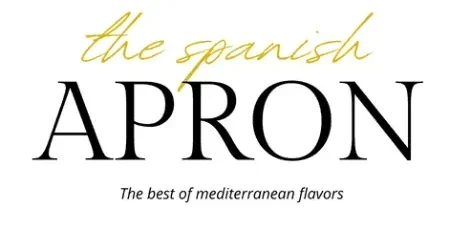
Delicious Spanish Paella: 10 Steps to Flavorful Bliss
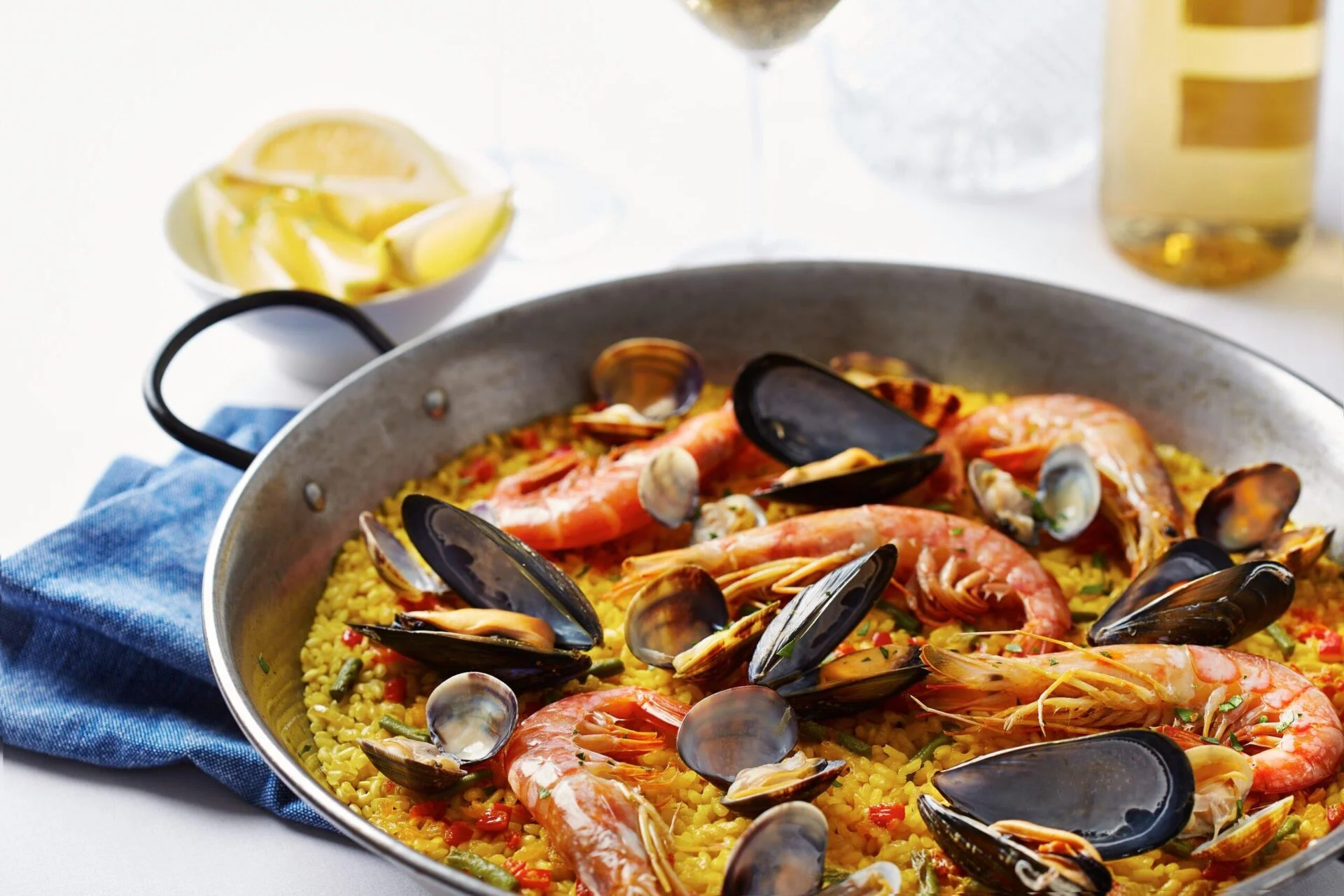
Welcome to “The Authentic Spanish Paella,” an exploration of the iconic dish that has captivated taste buds around the world. This article will take you on a gastronomic journey through the rich history, tantalizing variations, and essential tips and tricks to create the perfect paella. Whether you’re seeking the traditional Spanish paella recipe or an easy-to-follow version, this guide is your passport to mastering the art of this beloved culinary masterpiece. Prepare to immerse yourself in the flavors, aromas, and cultural significance of “The Authentic Spanish Paella” as we unlock its secrets together.
Table of Contents
The traditional spanish paella.
History: Embark on a trip back in time to the 18th-century Valencia region, where paella originated. Originally a humble dish for farmers, it combined readily available ingredients like rice, chicken, rabbit, and even snails. Over time, paella evolved into a beloved symbol of Spanish gastronomy.
Nutritional Benefits: Did you know paella can be surprisingly nutritious? Packed with protein from seafood or meat, carbohydrates from rice, and vitamins from vegetables, paella offers a well-rounded meal. Explore the variations below to find options that suit your dietary needs.
The Original Paella Variations
Paella isn’t a one-size-fits-all dish! Here are some enticing variations to tantalize your taste buds:
- Paella Valenciana: The traditional recipe, featuring chicken, rabbit, snails, and green beans.
- Seafood Paella: A delightful medley of fresh seafood like shrimp, mussels, and clams takes center stage.
- Mixed Paella: Craving both meat and seafood? This paella offers a harmonious fusion of flavors.
- Vegetarian Paella: A vibrant display of seasonal vegetables like artichokes, bell peppers, and peas creates a flavorful plant-based option.
The Classic Spanish Paella: Tips and Tricks
Mastering paella is easier than you think! Here are some secrets to achieving paella perfection:
- The Pan: Use a wide, shallow pan called a paellera for even heat distribution.
- The Rice: Spanish paella rice varieties like Bomba or Calasparra are your best friends. They hold their shape and soak up flavors beautifully.
- The Golden Touch: Authentic Spanish saffron adds the signature golden color and unique flavor to your paella.
- The Secret Crust: Don’t stir the rice excessively after adding broth. This allows the formation of a crispy, flavorful crust called socarrat.
- The Finishing Touch: Let your paella rest for a few minutes before serving. This allows the flavors to marry and come alive.
Spanish Recipe Inspiration Beyond Paella:
Spain boasts a diverse culinary landscape with regional specialties waiting to be explored. Here are a few ideas to expand your Spanish food journey:
- Gazpacho: A chilled Andalusian soup made with blended tomatoes, vegetables, garlic, and olive oil. Perfect for a hot summer day.
- Tortilla Española: A savory Spanish omelet made with potatoes, onions, and eggs. A versatile dish enjoyed hot or cold.
- Patatas Bravas: Crispy fried potatoes drizzled with a spicy tomato sauce and aioli. A popular tapas bar staple.
- Gambas al Ajillo (Shrimp with Garlic): Simple yet flavorful shrimp sauteed in olive oil with garlic and chili flakes.
- Croquetas: Crispy fried bechamel croquettes filled with various ingredients like ham , cheese, or mushrooms. Another popular tapas option.
- Crema Catalana: A rich and creamy custard dessert similar to crème brûlée, with a caramelized sugar topping.
- Churros: Long, deep-fried dough sticks served hot with a chocolate dipping sauce.
- Tarta de Santiago: A traditional almond tart from Galicia, often dusted with powdered sugar and featuring the silhouette of the Saint James cross.
Mastering the art of traditional Spanish paella opens up a world of culinary delights. With its rich history, tantalizing variations, and easy-to-follow recipe, you can embark on a gastronomic journey right in your kitchen. Remember these tips and tricks to create a memorable paella experience, and savor the vibrant flavors and textures that make this dish truly exceptional.
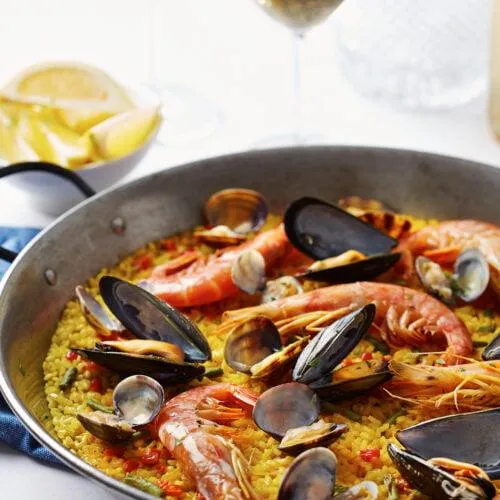
The Authentic Spanish Paella: History, Variations, Tips, and Tricks for a Delicious Culinary Adventure
- 1 Paella pan Large skillet
- 1 Oven optional
Ingredients
- 2 cups Spanish short-grain rice (such as Bomba or Calasparra)
- 4 cups Chicken or vegetable broth
- ½ lb Boneless chicken cut into bite-sized pieces
- ½ lb Shrimps peeled and deveined
- 1 Onion choped
- 4 Cloves of garlic minced
- 1 Red bell pepper chopped
- 1 Green bell pepper chopped
- 1 Can of diced tomatoes (14 oz)
- ½ cup Green peas
- ¼ cup Fresh parsley chopped
- ¼ cup Olive oil extra virgin
- 1 tsp Saffron threads
- Salt and pepper to taste
Instructions
- Preheat the oven to 375°F . (190 ºC)
- In a large paella pan or oven-safe skillet, heat olive oil over medium heat. Add chicken and cook until browned, about 5 minutes. Remove chicken from pan and set aside.
- Add onion, garlic, and bell peppers to the pan and cook until softened, about 5 minutes.
- Add rice to the pan and stir to coat with the vegetable mixture. Add saffron and stir to combine.
- Add chicken broth and diced tomatoes to the pan and stir to combine.
- Add chicken back to the pan and stir to combine.
- Bring mixture to a boil, then reduce heat to low and let simmer for about 10 minutes.
- Add shrimp and peas to the pan and stir to combine. Sprinkle salt and pepper to taste.
- Transfer pan to the oven and bake for 15-20 minutes or until the rice is cooked and the liquid has been absorbed.
- Remove from oven and let sit for a few minutes. Garnish with chopped parsley and serve hot.

Leave a Reply Cancel reply
Your email address will not be published. Required fields are marked *
- Kale by LyraThemes.com.
Spanish Paella Recipe
Posted on November 16, 2023
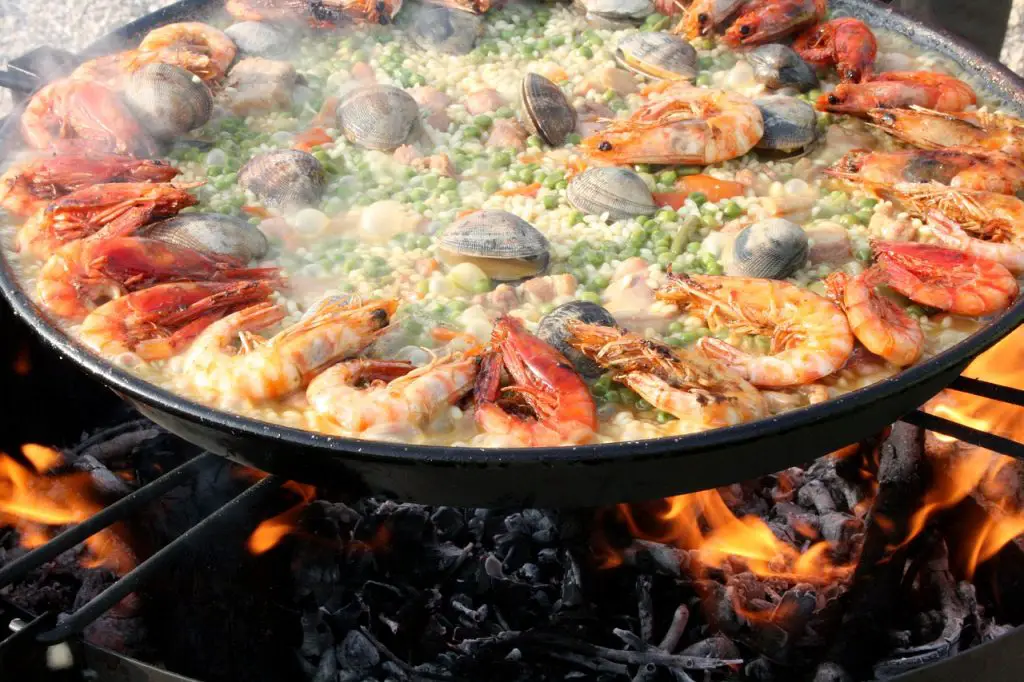
Cooking time
Spanish cuisine is a vibrant tapestry of flavors and regional specialties, and at the heart of this culinary tradition lies the beloved Spanish paella. This iconic dish, hailing from the Valencia region on the east coast of Spain, is a true reflection of the country’s rich history and diverse culture. With its aromatic saffron-infused rice, succulent seafood, and a medley of vegetables and spices, paella has captured the hearts and palates of food enthusiasts worldwide. In this comprehensive guide, we’ll delve into the history, the regional variations, and the step-by-step process of preparing an authentic Spanish paella.
I. A Glimpse into Paella’s Historical Roots
To truly appreciate the art of making paella, it’s important to understand its historical context. Paella, which takes its name from the wide, shallow pan it’s traditionally cooked in, has its origins in the fields of Valencia, where it was a simple, nourishing meal for farmers. The dish evolved over centuries, influenced by the various cultures that have shaped Spain’s history, including the Moors, who brought rice to the Iberian Peninsula.
Moorish Influence: Rice and Spices
The Moors introduced rice, saffron, and spices to the region, which became key components of paella. Saffron, with its vivid color and distinct flavor, is often considered the soul of paella, giving it its characteristic golden hue and a unique aroma.
The Role of Ingredients: Local and Seasonal
Traditional paella is a testament to the use of local and seasonal ingredients. Fresh seafood, such as mussels, clams, shrimp, and squid, are commonly used in coastal areas, while inland regions may feature rabbit, chicken, or snails. Fresh vegetables like bell peppers, tomatoes, and green beans are essential for adding depth of flavor and texture.
Social and Cultural Significance
Paella is more than just a meal; it’s a social event in Spain. Families and friends gather around the paella pan, often set up outdoors over an open flame, to share stories, laughter, and good food. This communal aspect of paella is a cherished tradition in Spanish culture.
II. Regional Variations of Spanish Paella
Spain’s diverse geography and culinary heritage have given rise to numerous regional variations of paella. Each variation showcases local ingredients and flavors, resulting in a delightful array of paella styles.
Valencian Paella
The original and most traditional form of paella, Valencian paella, is a celebration of simplicity and purity of ingredients. It typically features rabbit, chicken, or both, as well as snails and a variety of vegetables. Valencians take great pride in maintaining the authenticity of their paella, and deviations from the classic recipe are met with stern disapproval.
Seafood Paella
Hailing from the coastal regions of Spain, seafood paella is a treasure trove of maritime flavors. It showcases an abundance of fresh seafood, including prawns, mussels, clams, and squid. The seafood is often the star of the show, with minimal interference from other proteins.
Mixed Paella
Mixed paella, or paella mixta, is a popular variation that combines both seafood and meat. It harmoniously blends the flavors of chicken, rabbit, or pork with an assortment of seafood, creating a satisfying and well-rounded dish that appeals to a broad range of tastes.
Vegetarian Paella
For those who prefer a plant-based option, vegetarian paella offers a delectable alternative. This version replaces meat and seafood with an array of colorful vegetables, including artichokes, bell peppers, tomatoes, and green beans. It’s a celebration of the bountiful produce Spain has to offer.
Paella de Mariscos
Paella de mariscos is a seafood lover’s dream come true. This variation focuses exclusively on the ocean’s bounty, with an abundance of prawns, shrimp, clams, mussels, and squid. The seafood is complemented by aromatic saffron rice, creating a dish that’s both visually stunning and incredibly flavorful.
III. The Art of Making Authentic Spanish Paella
Now that we’ve explored the history and regional diversity of paella, let’s dive into the step-by-step process of creating an authentic Spanish paella. While there are variations in ingredients and techniques, the fundamental principles remain the same.
Ingredients (Serves 4-6):
2 cups of Spanish Bomba rice (or any short-grain rice) 1 lb of mixed seafood (prawns, mussels, clams, squid) 1/2 lb of boneless chicken thighs or rabbit, cut into bite-sized pieces 1/2 cup of green beans, trimmed and cut into 2-inch pieces 1 red bell pepper, thinly sliced 1 medium tomato, grated 1/2 onion, finely chopped 3 cloves of garlic, minced 1/4 teaspoon of saffron threads 1 teaspoon of smoked paprika (pimentón) 1/4 cup of extra-virgin olive oil 4 cups of chicken or seafood broth Salt and freshly ground black pepper to taste Lemon wedges and fresh parsley for garnish Equipment:
A wide, shallow paella pan (a traditional paellera) or a large skillet A heat source (gas burner, open fire, or charcoal grill) A wooden spoon or paella paddle
Step 1: Prepare the Saffron Infusion
In a small bowl, combine the saffron threads with a tablespoon of warm water. Allow it to steep and release its vibrant color and flavor. Step 2: Heat the Paella Pan
Place the paella pan over medium-high heat and add the olive oil. Allow it to heat until it shimmers. Step 3: Sear the Meat and Seafood
Season the chicken or rabbit pieces with salt and pepper. Add them to the pan and sear until they turn golden brown on all sides. Remove and set aside.
In the same pan, add the seafood and cook briefly until it just begins to turn opaque. Remove and set aside.
Step 4: Sauté the Vegetables
In the same pan, add the chopped onion, minced garlic, and sliced red bell pepper. Sauté until the vegetables soften and become fragrant.
Step 5: Incorporate the Tomatoes and Paprika
Add the grated tomato and smoked paprika to the pan. Cook for a few minutes until the tomato breaks down and the mixture thickens.
Step 6: Add the Rice and Saffron
Sprinkle the rice evenly over the vegetables and stir to coat the rice with the tomato mixture.
Pour in the saffron infusion and distribute it evenly across the pan. This will infuse the rice with the signature golden color and aroma of saffron.
Step 7: Pour in the Broth
Carefully pour the chicken or seafood broth into the pan. Ensure that the rice is evenly distributed.
Step 8: Arrange the Meats and Seafood
Return the seared chicken or rabbit pieces to the pan and arrange them evenly.
Place the seafood on top of the rice, arranging it decoratively.
Step 9: Simmer and Cook
Reduce the heat to medium-low and let the paella simmer gently. Avoid stirring the rice from this point on, as the formation of the coveted “socarrat” (a caramelized, crispy rice crust at the bottom) requires undisturbed cooking.
Step 10: Achieve the Socarrat
Continue simmering until the liquid is mostly absorbed, and the rice begins to form a crust on the bottom, usually around 15-20 minutes. You’ll hear a crackling sound, which is a sign that the socarrat is forming.
Taste the rice for doneness. It should be tender but with a slight bite (al dente). If necessary, add a bit more broth and continue cooking.
Step 11: Rest and Serve
Remove the paella from the heat and let it rest for a few minutes. This allows the flavors to meld together.
Garnish the paella with lemon wedges and fresh parsley.
IV. Tips for Perfecting Your Paella
Use high-quality ingredients, including Spanish Bomba rice, saffron threads, and fresh seafood.
Maintain a consistent heat source to ensure even cooking.
Avoid stirring the paella once you’ve added the broth to encourage the formation of socarrat.
Customize your paella with your favorite ingredients, but stay true to the regional style you’re aiming for.
Serve paella with a crisp white wine or a refreshing sangria for the perfect pairing.
Spanish paella is more than just a dish; it’s a symbol of Spain’s rich culinary heritage, reflecting the country’s diverse regions, cultures, and flavors. Whether you prefer the simplicity of Valencian paella, the seafood extravaganza of paella de mariscos, or any of the other delightful variations, making paella is an art form that anyone can master with practice and dedication. So, gather your friends and family, fire up the paella pan, and embark on a delicious journey through Spain’s culinary traditions with this authentic Spanish paella recipe.
The Legacy of Paella in Modern Cuisine
Spanish paella has transcended its humble origins and become a global sensation, beloved by food enthusiasts around the world. Its versatility and ability to accommodate a wide range of ingredients have made it a staple in modern cuisine. Paella has also inspired chefs to experiment with innovative variations, incorporating ingredients from different culinary traditions while still honoring its core principles.
Fusion Paella: Chefs around the world have embraced fusion cuisine, combining the flavors of paella with ingredients and techniques from other cultures. You might encounter paella with Asian, Latin American, or Middle Eastern influences, creating exciting new flavor profiles.
Paella Parties: Paella has become a popular choice for outdoor gatherings and celebrations. Hosting a paella party, where guests can watch the paella being cooked and then enjoy it together, has become a trend in many parts of the world.
Paella Cook-Offs: Competitions and cook-offs centered around paella have gained popularity. These events allow amateur and professional chefs alike to showcase their skills and creativity while paying homage to this iconic dish.
VII. The Future of Paella
As paella continues to evolve and adapt to modern tastes, its future is bright. The dish’s enduring appeal lies in its ability to bring people together, whether around a traditional wood-fired paella pan or in contemporary culinary settings. Paella represents not only the flavors of Spain but also the warmth of Spanish hospitality and the joy of communal dining.
In recent years, efforts have been made to preserve the authenticity of paella, particularly in the Valencian region, where it holds deep cultural significance. Organizations and associations have been established to protect traditional paella recipes and methods, ensuring that this cherished culinary heritage endures for generations to come.
VIII. Frequently Asked Questions
Can I use a regular skillet or pan to make paella if I don’t have a paella pan?
While a traditional paella pan, known as a paellera, is the ideal choice, you can use a wide, shallow skillet or pan as a substitute. Just be sure it can comfortably accommodate all the ingredients.
What type of rice should I use for paella?
Spanish Bomba rice is the preferred choice for paella due to its ability to absorb flavors and remain firm while cooking. However, you can use other short-grain rice varieties if Bomba rice is not available.
Can I make paella with frozen seafood?
Fresh seafood is preferred for its superior flavor and texture, but you can use frozen seafood if necessary. Thaw it before adding it to the paella, and be mindful not to overcook it.
What if I don’t have saffron?
Saffron is a crucial ingredient in paella, but if you don’t have it, you can use a pinch of ground turmeric for color and a mild flavor substitute.
Is it possible to make a vegetarian or vegan paella?
Absolutely! You can create a delicious vegetarian or vegan paella by substituting meat and seafood with an assortment of vegetables, beans, or plant-based protein sources like tofu or tempeh.
Spanish paella is not just a recipe; it’s a cultural treasure that invites you to explore the flavors and traditions of Spain. Whether you choose to prepare a traditional Valencian paella, a seafood extravaganza, or a creative fusion of flavors, making paella is a culinary journey that connects you with the essence of Spanish cuisine.
As you embark on your paella-making adventure, remember that practice makes perfect. The more you cook paella, the better you’ll become at achieving that elusive socarrat and balancing the flavors of this iconic dish. So, gather your loved ones, raise a glass of Spanish wine, and savor the magic of Spanish paella, a culinary masterpiece that has captured hearts and palates for centuries. ¡Buen provecho!
Beginner-friendly recipes / Coffee Recipes / Easy Recipes / Pho GA / Quick recipes / recipe / Recipe collections / Spanish Paella Recipe / Tea recipes
You might also like these recipes

THE 15 BEST Restaurants Near The Gulch – Nashville

Shrimp Spring Rolls Recipe

Sinigang Recipe
- Search the site Please fill out this field.
- Saved Recipes & Collections
- Add a Recipe
- Manage Your Subscription
- Give a Gift Subscription
- Newsletters
- Sweepstakes
- Main Dishes
- Paella Recipes
Easy Paella
Paella is a classic Spanish dish featuring saffron rice with chorizo, chicken, and seafood. This easy recipe marinades the chicken in paprika and oregano for added flavor and adds the shrimp at the last minute for fantastic results. Serve this delicious paella in the center of your table so everyone can dig in.
Ingredients
2 tablespoons olive oil
1 tablespoon ground paprika
2 teaspoons dried oregano
salt and ground black pepper to taste
2 pounds skinless, boneless chicken breasts, cut into 2 inch pieces
2 tablespoons olive oil, divided
3 cloves garlic, crushed
1 teaspoon crushed red pepper flakes
2 cups uncooked short-grain white rice
1 pinch saffron threads
1 large bay leaf
½ bunch Italian flat leaf parsley, chopped
1 quart chicken stock
2 medium lemons, zested
1 medium Spanish onion, chopped
1 medium red bell pepper, coarsely chopped
1 pound shrimp, peeled and deveined
1 pound chorizo sausage, casings removed and crumbled
Mix olive oil, paprika, oregano, salt, and pepper for marinade in a glass bowl.
Begin paella: Add chicken and stir to coat. Cover and refrigerate until needed.
Heat 2 tablespoons olive oil in a large skillet or paella pan over medium heat. Stir in garlic and pepper flakes, then stir in rice. Cook and stir until rice is coated with oil, about 3 minutes.
Add saffron threads, bay leaf, parsley, chicken stock, and lemon zest. Stir until well combined and bring to a boil. Reduce heat to medium-low, cover, and simmer for 20 minutes.
While the rice is cooking, heat olive oil in a separate skillet over medium heat. Stir in marinated chicken and cook for 3 minutes. Add onion and cook until translucent, about 5 minutes.
Add bell pepper and sausage; cook and stir, breaking sausage up with a spatula, for 5 minutes. Add shrimp; cook and stir until shrimp are bright pink on the outside and the meat is opaque, about 2 minutes.
Photographer: Jen Causey, Food Stylist: Ruth Blackburn
Spread rice mixture onto a serving tray. Top with meat and seafood mixture.
DOTDASH MEREDITH FOOD STUDIOS
Nutrition Facts (per serving)
* Percent Daily Values are based on a 2,000 calorie diet. Your daily values may be higher or lower depending on your calorie needs.
** Nutrient information is not available for all ingredients. Amount is based on available nutrient data.
(-) Information is not currently available for this nutrient. If you are following a medically restrictive diet, please consult your doctor or registered dietitian before preparing this recipe for personal consumption.
Photos of Easy Paella
DOTDASH MEREDITH FOOD STUDIOS
You’ll Also Love

- All Recipes
- Soups & Salads
- Main Dishes
- My Amazon Shop

Seafood Paella that will Transport you to Spain | Quick & EASY Recipe
This Spanish Seafood Paella is so good that with each bite, you will be transported to beautiful España. We’re talking authentic flavors, fool-proof easy to make and done in just 40 minutes. Serve it next to a crunchy baguette and a bottle of Spanish wine from the region of Utiel-Requena for an incredible meal.

TIPS & TRICKS to Make this Recipe: Once you add the rice to the pan, give it one final mix. Do not mix again. As it will disrupt the way the rice cooks and start releasing its starch.

Key Ingredients & Cookware I used in this Recipe: MY COOKWARE MY CHEF´S KNIFE EXTRA VIRGIN SPANISH OLIVE OIL GOLDEN SAFFRON SPANISH PAPRIKA (25% OFF Your Order if you Purchase from this Link)
If you´re not already subscribed to my youtube channel, become a subscriber and click on the bell icon to be notified everytime I release a new video.

Watch the Video Below on How to Make this EASY Spanish Seafood Paella

EASY Spanish Seafood Paella | Paella de Mariscos
Ingredients.
- 3 tbsp extra virgin olive oil 45 ml
- 1 small onion
- 5 cloves garlic
- 1 red bell pepper
- 1 tsp sweet smoked Spanish paprika 2.50 grams
- 2 tomatoes (finely grated)
- 3 cups fish broth 720 ml
- 1/4 tsp saffron threads
- 1 cup Spanish round rice 190 grams
- 2 cod fillets 7 oz / 200 grams each
- 1/2 lbs raw jumbo shrimp (peeled & deveined) 225 grams
- sea salt & black pepper
- parsley for garnish
Instructions
Heat a paella pan with a medium heat and add in the olive oil (the pan I used was 12 inches (30 cm) in diameter)
In the meantime, finely chop the onion, roughly chop the garlic and finely chop the red bell pepper
Add the chopped vegetables into the hot paella pan, mix continuously, after 3 to 4 minutes and vegetables are lightly sauteed, add in the paprika, quickly mix together, then add in the tomatoes finely grated and season with sea salt & black pepper, mix together and then simmer
After 3 to 4 minutes and the grated tomato has slightly thickened, add in the fish broth and saffron, raise to a high heat and give it a gentle mix, once it comes to a boil add in the rice, give it one final mix so everything is evenly distributed, then simmer without mixing
In the meantime, add the cod fillets over some paper towels and pat dry, then season with sea salt & black pepper and cut each fillet into bite-size pieces, add the shrimp over paper towels as well and pat dry, season with sea salt & black pepper
After simmering the rice for 10 minutes and a lot of the broth has been absorbed but there is still plenty of liquid left, lower to a low-medium heat, add in the pieces of cod and shrimp, all in single layer and evenly spaced out, simmer for another 8 to 10 minutes or until all the broth has been absorbed and the seafood is cooked through, then turn it up to a medium-high heat and go for 1 to 2 minutes, this is to achieve the socarrat (caramelized burnt rice underneath), then remove the pan from the heat and cover with foil paper and a dish cloth
After 2 to 3 minutes uncover the pan, garnish with lemon wedges and fresh parsley, enjoy!
Recipe Notes
Get the Golden Saffron and Spanish Paprika I used to make this Recipe
Disclosure: At Spain on a Fork, we offer affiliate links to help you find what you need to re-create our recipes. If you like what we do, you can support us through our chosen links, which earn us a commission, but you still pay the same price. Learn more here .
You May Also Like
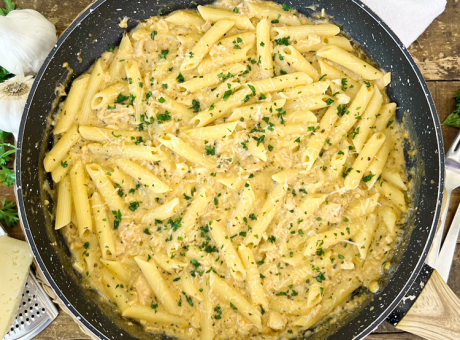
CREAMY Garlic Tuna Pasta | Packed with GOODNESS & Easy to Make
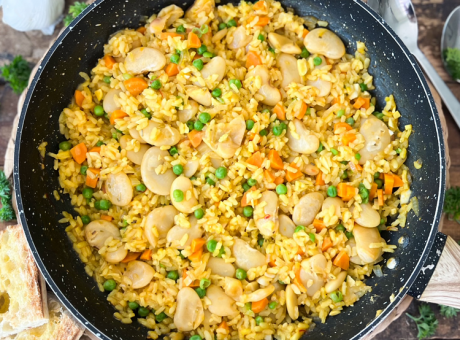
Delicious Spanish Rice with Butter Beans | No Meat + Gluten Free!
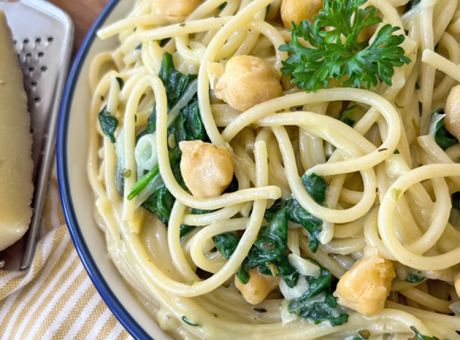
Possibly the BEST Vegetarian Pasta | Creamy Chickpea & Spinach Spaghetti
Jackie Robinson
Spain on a Fork
Happy to hear that! Thanks for the comment 🙂 Much love
Cancel Reply
Your email address will not be published. Required fields are marked *
Save my name, email, and website in this browser for the next time I comment.
Notify me of follow-up comments by email.
Notify me of new posts by email.
Subscribe to our Newsletter
Receive 3 organizing printables🌟Pantry Labels + Party Menu Planner + Weekly Meal Planner
- Skip to primary navigation
- Skip to main content
- Skip to primary sidebar

- Tried & True Mediterranean Recipes
- Privacy Policy
The Best Spanish Seafood Paella 🥘 Recipe
September 14, 2020 by Heidi 16 Comments
Sharing is caring❤️!
Get ready for some YUM!😋 This is hands down, the easiest and tastiest “Spanish Seafood Paella 🥘 Recipe”. Let’s talk about how gorgeous this dish is, look at it! It is a statement itself!
With its vibrant colors and delicious mixture of flavors! Adding to it the ton of amazing flavor “Saffron” brings!
You will get the WOW 🤩 factor in your next party with this delicious “Spanish Seafood Paella Recipe”.
Check my Parties & Hosting favorite / Essential list 😉
This dish is a mixture of rice, veggies, infused with Saffron, and different spices. Packed with a combination of seafood: shrimps, mussels, calamari, lobster’s tail, fish fillet, and clams
“contains commissionable links! As an Amazon Associate, I earn from qualifying purchases”
what is paella 🥘 ?
Paella is a widely known dish from Spain. It was first cooked by the Valencian farmers on the eastern coast of Spain. They would cook medium grain-rice with whatever was available from meat and vegetables. One of the newest or modern versions is the seafood Paella.
Saffron, is the main spice that adds a ton of flavor and gives the rice this amazing color.
It is known to be cooked in a “paellera” a large, flat, open round steel pan with two handles.
The dish paella takes its name from the pan. It is believed that the word “paella” comes from the name of the pan it is made in - the Latin term patella.
Do I need a Paella pan?
No, you don’t. You can use any skillet or even any shallow & wide pan. Keep in mind, that your layer of rice should be no more than 2 or 2 1/2 inches deep. So the rice cooks quickly and evenly.
I cook Paella more often, that’s why I decided to go ahead and buy one.
My family and friends love Paella, serving it in a Paella Pan makes a statement on the dining table.
What to put in a Paella?
This dish is a one-pot meal so it is a PERFECT party dish! check out my favorite Paella Pan
The main ingredient is rice, you can find Paella rice sold in grocery stores but it can be a bit expensive. I found that using medium-grained rice works great.
I like using “Uncle Ben's” rice for this dish, it absorbs the liquid and flavor and maintains its firmness.
2 - THE STOCK:
I like using either vegetable stock or chicken stock for this dish, whatever is available. The stock adds richness and depth to the flavor. Be sure to taste the stock and adjust the season as needed.
If you can get your hands on fish or seafood stock that would be even better, but I found that vegetable or chicken stock works perfectly.
3- SAFFRON :
This is one of the main ingredients, try not to skip it. It really makes a difference in the Paella flavor.
Saffron is an expensive spice, but luckily, we only need a few threads. Try to get a good quality one, don’t worry a small box will last you a long time. Just keep it in an airtight container and away from direct sun.
4- THE SOFRITO :
It is the base of your dish. The combination of onion, garlic, tomato and peppers all sautéed in olive oil. I like to add to those celery and leeks they really richens the flavor more.
5- THE SEAFOOD:
what to put in the Paella? The answer is anything!
You can add any seafood you like. You can use more than 2 or even just one. We are big on seafood that’s why I added different kinds of seafood.
Tip: try adding 3 or 4 shrimps 🦐 heads-on if available, I noticed that it makes a big difference in the richness of the flavor.

Spanish Seafood Paella Recipe
Ingredients 1x 2x 3x.
- ▢ 2.5 cup Short-grain rice “Uncle Ben's” or any Paella Rice
- ▢ 3 cup Vegetable stock or chicken stock
- ▢ 2 cup Water
- ▢ ½ cup Colored Peppers
- ▢ ½ cup Yellow onion, finely chopped
- ▢ 5 cloves Garlic, finely chopped
- ▢ ½ cup Diced Tomatoes
- ▢ ¼ cup Frozen peas & carrots
- ▢ ¼ cup leeks, sliced thin
- ▢ ¼ cup celery, small cubes
- ▢ 3 Tablespoon Olive oil
- ▢ ¼ cup Parsley for Garnish
- ▢ 1 tablespoon Saffron Threads
- ▢ 1 teaspoon Garlic powder
- ▢ 1 teaspoon Onion powder
- ▢ 1 teaspoon Turmeric
- ▢ 1 teaspoon Coriander
- ▢ 1 teaspoon Paprika
- ▢ 2 Bay leaves
- ▢ ½ teaspoon Black pepper
- ▢ 1 teaspoon Cumin
- ▢ ½ teaspoon Salt or to taste
- ▢ ½ cup Peeled shrimp
- ▢ 5 large Shrimps, Heads on
- ▢ ½ cup Calamari, cut into rings
- ▢ ½ cup Mussels, rinsed & scrubbed
- ▢ ½ cup Clams, rinsed & scrubbed
- ▢ 1 Lobster’s tail, cut in half vertically
- ▢ ½ cup Fillet fish cubes I used Swai
Instructions
Step 1” saffron”.
- 1- In a small pan, bring vegetable stock to boil then add the “Saffron”.
- Wait a few minutes then remove from heat and step aside.
Step 2” Paella”
- In a Paella pan “or any similar skillet” heat oil over medium heat.
- Sautee onions for 2 minutes then add the celery, leeks, colored peppers & garlic. Stirring regularly.
- Add the rest of the spices: Garlic powder , Onion powder, Turmeric, Coriander, Paprika, Bay leaves, Black pepper, cumin &Turmeric. Stir regularly
- Add the peas & carrots, then add the calamari, Stir regularly for 3 minutes
- Add rice then diced tomatoes. Stir for 2 minutes
- Now add “step 1” – The Mixture of vegetable’s stock & Saffron” then the water
- Now, arrange the rest of the seafood start by adding the peeled shrimp, fish fillet, shrimp heads-on, lobster’s tail, mussels & clams.
- Bring to boil then lower the heat a bit and cover. Cook for 15 minutes, until the liquid, is fully absorbed or until its fully cooked
- Garnish with parsley, serve with lemon wedges on the side. Serve and enjoy!
- You can add any seafood you like. You can use more than 2 or even just one. We are big on seafood that’s why I added different kinds of seafood.
- Tip: try adding 3 or 4 shrimps heads-on if available, I noticed that it makes a big difference in the richness of the flavor.
- Fish: try to add a thick kind of fillet fish not thin, I used Swai. Tilapia is a good option too.
- This Paella is a one-pot meal so it is a PERFECT party dish!
for your recipe fix & a special SURPRISE!
Reader Interactions
October 07, 2020 at 4:01 pm
That plate looks delicious 😋😍
October 09, 2020 at 3:04 pm
October 09, 2020 at 3:20 pm
Thanks for the tips, I really appreciate you taking the time to share your recipe. I will try your recipe version, I am sure it will be delicious too! By the way, Valencia is one of my top places on my list to visit. I would love to try the authentic food over there 😋
October 10, 2020 at 3:31 pm
You'll love It for sure. Is a very nice city!
October 15, 2020 at 12:14 am
Definitely ☺️
June 16, 2024 at 9:55 pm
Hi Alba, Thank you for the ingredient details Ive only made mine with Saffron and salt ... I will be adding chicken with the seafood
October 09, 2020 at 4:34 pm
Actually i tried it and it has a real breathtaking smell and color also very easy recipe i tried at on of my family dinners and it was the star of the dinner🤩🤩🤩thank you!
October 09, 2020 at 4:43 pm
I am glad you liked it , if you got a picture please tag me on Instegram or Facebook 🤩 it’s the perfect party dish
October 09, 2020 at 5:31 pm
October 10, 2020 at 12:23 pm
I am glad you liked it, its a family favorite 🤩😋
October 09, 2020 at 7:09 pm
October 10, 2020 at 12:24 pm
thanks, Suzy 😋🤩
October 10, 2020 at 12:38 pm
June 14, 2021 at 10:45 pm
I cooked it twice this past weekend for friends and family
They loved it !!! I didn’t add onion or carrots
Pair it with a Sangria . Salud !!! 🍷
Leave a Reply Cancel reply
Your email address will not be published. Required fields are marked *
Save my name, email, and website in this browser for the next time I comment.
This site uses Akismet to reduce spam. Learn how your comment data is processed .
Privacy Overview
www.sbs.com.au/food
Similar to a paella in that it is cooked in a large shallow pan, this lesser known seafood-rich dish uses pasta instead of rice as its base. Food Safari Water
preparation
Ingredients
- 125 ml (½ cup) olive oil
- 12 green medium tiger prawns, unpeeled
- 1 onion, finely chopped
- 6 garlic cloves, finely chopped
- 2 tsp sweet paprika
- 2 tsp ground roasted nora peppers
- 500 g calamari, cleaned, scored and cut into 2-3 cm pieces
- 500 g snapper, flesh cut into 2-3 cm chunks, carcass reserved
- 500 g rock ling, flesh cut into 2-3 cm chunks, carcass reserved
- 500 g tuna, cut into 2-3 cm chunks
- Salt, to taste
- 500 g fideos or spaghettini, cut into 3 cm lengths (see Note)
- 250 ml (1 cup) tomato puree (see note)
- 2 pinches saffron threads (lightly crushed and steeped in some of the fish stock)
- ½ tsp saffron colouring (optional)
- 500 g prawns, peeled and cleaned, shells reserved
- 1 small bunch parsley, leaves picked and finely chopped
- 50 ml dry sherry
- ½ kg local black mussels, scrubbed and de-bearded
- 1 lemon, cut into wedges
- Alioli, to serve
- 1 leek, coarsely chopped
- 1 large onion, coarsely chopped
- 4 celery stalks, coarsely chopped
- 4 large carrots, coarsely chopped
- 1 large ripe tomato, quartered
Instructions
Cook's notes.
Oven temperatures are for conventional; if using fan-forced (convection), reduce the temperature by 20˚C. | We use Australian tablespoons and cups: 1 teaspoon equals 5 ml; 1 tablespoon equals 20 ml; 1 cup equals 250 ml. | All herbs are fresh (unless specified) and cups are lightly packed. | All vegetables are medium size and peeled, unless specified. | All eggs are 55-60 g, unless specified.
Have a story or comment? Contact Us
Share this with family and friends
More recipes like this

Tigretón's seafood paella

Paella Valenciana

Blue swimmer crab paella

Supreme cataplana

Seafood boil
Modern Australian

Ian Parmenter's paella
Sbs food newsletter, get your weekly serving. what to cook, the latest food news, exclusive giveaways - straight to your inbox..
By subscribing, you agree to SBS’s terms of service and privacy policy including receiving email updates from SBS.
Bring the world to your kitchen

IMAGES
VIDEO
COMMENTS
Heat the oil in a large paella pan (or frying pan) over medium heat. Add the onion, garlic, tomato, fresh capsicum, chicken, squid and rice and stir for 1 minute.
Food Safari's paella. Food Safari's paella. 4y. Matthew Aitch. Cat Anne . 4y. View more comments. 2 of 108 ...
Paella is - next to tortilla and tapas - Spain's internationally most well-known dish. The original recipe comes from Valencia, which is located at the Spani...
When someone mentions Spanish cuisine, most likely Paella comes to mind. A lot of non-Spaniards regard it as Spain's national dish when in fact, most Spaniards view it as a regional Valencia dish.Mainly there are three types of paella: Valencian paella ( paella valenciana), seafood paella ( paella de marisco) and mixed paella ( paella mixta), but there are literally hundreds of recipes and ...
Add onion, bell peppers and garlic and sauté until onion is translucent. Add chopped tomato, bay leaf, paprika, saffron, salt and pepper. Stir and cook for 5 minutes. 2. Add white wine. Cook for 10 minutes. 3. Add chicken & rice. Add chopped parsley and cook for 1 minute.
Begin by heating the olive oil in a pan over medium heat. Once the oil is hot, add the diced onion, minced garlic, and diced red bell pepper. Sauté the mixture, stirring occasionally, until the vegetables become soft and fragrant, about 3-5 minutes. Stir in the diced tomatoes, paprika powder, and saffron threads.
In the Valencian community where paella comes from, saffron is one of the 10 basic ingredients required for an authentic "paella Valenciana.". You can use saffron powder straight to the paella, or saffron threads: soak them in a couple of tablespoons of water for 10 minutes and then add it all to the paella. 3.
In each episode of Food Safari, Maeve O'Meara visits a different cuisine, taking you into kitchens and restaurants across the nation to learn new recipes.
Instructions. Preheat the oven to 375°F . (190 ºC) In a large paella pan or oven-safe skillet, heat olive oil over medium heat. Add chicken and cook until browned, about 5 minutes. Remove chicken from pan and set aside. Add onion, garlic, and bell peppers to the pan and cook until softened, about 5 minutes.
Spanish cuisine is a vibrant tapestry of flavors and regional specialties, and at the heart of this culinary tradition lies the beloved Spanish paella. This iconic dish, hailing from the Valencia region on the east coast of Spain, is a true reflection of the country's rich history and diverse culture. With its aromatic saffron-infused rice, succulent seafood, and a medley of vegetables and ...
Stir in garlic and pepper flakes, then stir in rice. Cook and stir until rice is coated with oil, about 3 minutes. Add saffron threads, bay leaf, parsley, chicken stock, and lemon zest. Stir until well combined and bring to a boil. Reduce heat to medium-low, cover, and simmer for 20 minutes.
You can smell the heady scents of saffron, paprika and garlic as host Maeve O'Meara investigates the key ingredients needed to create a Spanish pantry and vi...
Heat the oil in a large paella pan (or frying pan) over medium heat. 4. Add the onion, garlic, tomato, fresh capsicum, chicken, chorizo and rice and stir for 1 minute.
Add the chopped vegetables into the hot paella pan, mix continuously, after 3 to 4 minutes and vegetables are lightly sauteed, add in the paprika, quickly mix together, then add in the tomatoes finely grated and season with sea salt & black pepper, mix together and then simmer.
In a Paella pan "or any similar skillet" heat oil over medium heat. Sautee onions for 2 minutes then add the celery, leeks, colored peppers & garlic. Stirring regularly. Add the rest of the spices: Garlic powder, Onion powder, Turmeric, Coriander, Paprika, Bay leaves, Black pepper, cumin &Turmeric. Stir regularly.
Instructions. Place the carrot, celery, onion and garlic in a food processor and process until finely chopped. Place the stock in a saucepan and bring to the boil. Keep warm. Heat the olive oil ...
Pa-Paella, Moscow: See 423 unbiased reviews of Pa-Paella, rated 4.5 of 5 on Tripadvisor and ranked #30 of 11,581 restaurants in Moscow. Skip to main content. ... Yummy and not pricey Spanish food. Will come back for dinner for sure! Read more. Written March 30, 2021. This review is the subjective opinion of a Tripadvisor member and not of ...
Review. Share. 8 reviews. #3,503 of 10,729 Restaurants in Moscow $, Mediterranean, Spanish, Eastern European. 26 Leninsky Sloboda Str. Building 1, Moscow 115280 Russia. +7 909 644-57-52 + Add website. Open now 10:00 AM - 10:00 PM. Improve this listing.
Food Safari's paella. ratings · 1hr 15min · 4 servings. Traditionally, paella is made on a Sunday and because women need a day off from cooking it is usually made by the men. I have bought a paella pan and gas ring so my family are always enjoying this lovely dish. ... Easy Spanish Seafood Paella recipe made with the freshest wild caught ...
Instructions. Heat oil in a 34 cm paella pan over medium heat. Add garlic and cook for 2 minutes or until golden. Add chicken and cook for 2 minutes or until browned. Add thyme, onion and capsicum ...
Pa-Paella: Spanish cuisine, fine wines - See 423 traveler reviews, 490 candid photos, and great deals for Moscow, Russia, at Tripadvisor.
Heat the olive oil in a 60 cm paella pan over medium heat. Add the tiger prawns and fry for 2 minutes. Remove from the pan and set aside. Add the onion and garlic, fry for 1 minute, then add the ...
Tasty food! Excellent quality. I took beef tartare and it was... Right place for the best food and wine! 3. Lyubov Pirogova 201 ... a paella with... Valentine's day review. 28. Odessa-Mama. 378 reviews Closed Now. European, Russian $$ - $$$ Menu. Mainly for fish lovers. Ukrainian and russian specialties, homemade, tasty... Perfect spot for ...